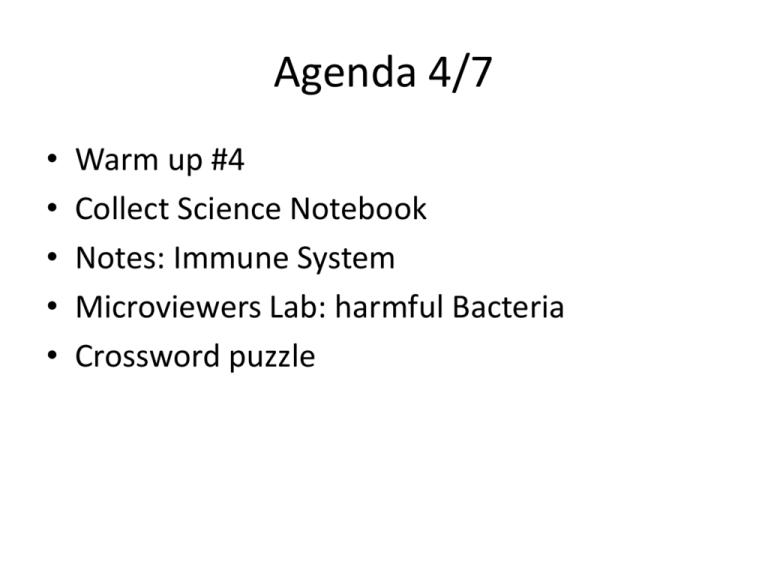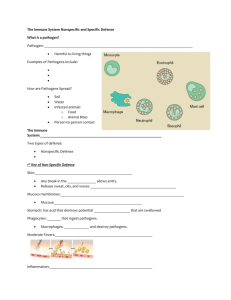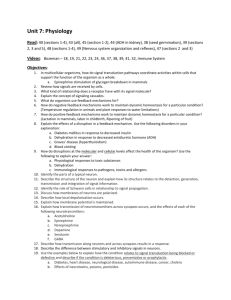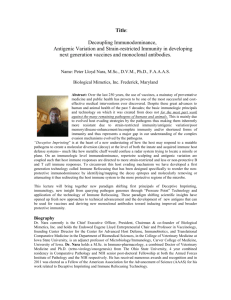Immune System
advertisement

Agenda 4/7 • • • • • Warm up #4 Collect Science Notebook Notes: Immune System Microviewers Lab: harmful Bacteria Crossword puzzle Warm up 4: Intro to Immune System 1. How do we fight off bacterial infections? 2. How can we prevent viral diseases? 3. What does it mean to be immune to something? 4. What do you suppose the job of the immune system is? Immune System Let’s Get Defensive I. Pathogens Cause Infectious Disease A. Infectious disease 1. Caused when a pathogen is passed from one organism to another B. Pathogens 1. Bacteria 2. Viruses 3. Fungi 4. Parasites 5. Protozoans Parasitic Pathogens Example: Botfly https://www.youtube.com/watch?v=KNDG7WPt VO4 Pathogenic Protozoa Giardia: occurs by swallowing contaminated water, by eating contaminated food or through person-to-person contact https://www.youtube.com/ watch?v=bGMor71WkFc Music video: https://www.youtube.com/ watch?v=2R7fTTsXQzY II. Spread of Disease A. Types of Reservoirs 1. Human (Direct or Indirect Contact) i. Main reservoir for pathogens that affect humans ii. Individual that is symptom-free but capable of passing the pathogen is called a carrier II. Spread of Disease Cont. 2. Animal (Vector) i. Other animals also are reservoirs of pathogens that can be passed to humans, such as influenza and rabies. 3. Others (Direct Contact) i. Soil ii. Contaminated water or food III. Treating and Fighting Disease A. Antibiotic is a substance that can kill or inhibit the growth of bacteria 1. 2. 3. 4. Penicillium (bacteria) Erythromycin (fights Diphtheria) Neomycin (creams, ointments, and eye drops) Gentamicin (helps fight UTIs) Diphtheria Agenda 4/8 1. Warm up 5 2. Notes: Immune System 3. Documentary BBC Horizon: Pandemic Diseases *Homework: Crossword puzzle (extension… Thursday) *Warrior Lab Friday Warm up 5: Infectious Disease 1. What is an infectious disease? 2. What is a pathogenic reservoir? 3. What are 3 types of pathogenic reservoirs? Give an example for each. 4. A botfly is considered what type of pathogen? What about Giardia? I. Immune Response A. purpose of the immune response is to inactivate or destroy pathogens, abnormal cells, and foreign molecules Immune System II. Nonspecific Immunity A. Body has a number of defenses in the immune system that fight off pathogens B. Defenses are nonspecific 1. Not aimed at a specific pathogen C. Help prevent disease D. Help slow progression of disease III. Antibodies A. a protein produced by plasma cells that is used in the immune system to identify foreign objects such as bacteria and viruses Immune System IV. Skin Barrier A. Skin cells 1. protect against invasion by microorganisms B. Bacteria that live symbiotically on the skin digest skin oils to produce acids 1. Inhibit many pathogens Immune System V. Chemical Barriers A. Saliva, tears, and nasal secretions contain lysozyme (enzyme) 1. Breaks down bacterial cell walls and kills pathogens B. Mucus acts as a protective barrier 1. Blocks bacteria from sticking to inner epithelial (skin) cells Immune System VI. Nonspecific Responses to Invasion A. Body has nonspecific immune responses to pathogens that get beyond its barriers 1. Cellular defense i. Phagocytosis – release enzymes or other chemicals to destroy pathogen 2.Interferon (protein) i. Virus infected cells; prevents replication 3. Inflammatory response i. More blood flow brings in more white blood cells Pandemic Diseases https://www.youtube.com/watch?v=jESeN63qN cM Agenda 4/9 1. Warm up 5 2. Notes: Specific Immunity 3. Documentary BBC Horizon: Pandemic Diseases *Homework: Crossword puzzle (due tomorrow) *Warrior Lab Friday Warm up 6: Nonspecific Immunity 1. What is our body’s first defense against microorganisms? 2. What are the chemical barriers our body produces? 3. If microorganisms get past your first line of defenses what do you suppose will happen next? 4. What is the purpose of phagocytosis, and how does it work? Immune System VII. Specific Immunity A. Lymphatic system 1. Organs and cells i. Filter lymph and blood ii. Destroy foreign microorganisms 2. Defend body against infections Immune System VIII. Lymphatic Cells A. Lymphocytes – white blood cell that is produced in red bone marrow 1. Protect the body i. T cells (T lymphocytes) • Manage immune response • Directly attack and destroy infected cells ii. B cells (B lymphocytes) • Differentiate into plasma cells that secrete antibodies (mark antigens, aka name tags, for destruction) B. Macrophages – phagocytize foreign matter and activate T cells https://www.youtube.com/watch?v=7VQU28itVVw Immune System IX. Passive Immunity A. Temporary protection 1. Occurs when antibodies are made by other people or animals and are transferred or injected into the body i. Between mother and infant ii. To treat tetanus and rabies iii. To inactivate snake and scorpion venoms Immune System X. Active Immunity A. Active immunity occurs after immune system is exposed to disease antigens 1. Memory cells are produced 2. Can result from having an infectious disease B. Immunization 1. Deliberate exposure of the body to an antigen 2. Primary response and immune memory cells develop Immune System XI. Immune System Failure A. Some diseases can affect the immune system’s effectiveness 1.Acquired Immunodeficiency Syndrome (AIDS) 2. HIV infects mainly helper T cells i. Helper T cells become HIV factories, producing new viruses ii. Number of helper T cells in an infected person decreases Pandemic Diseases https://www.youtube.com/watch?v=jESeN63qN cM








